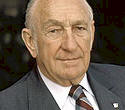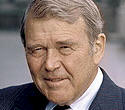by
James Redin
"Our object in developing the HP-35 was to give you a high precision portable electronic slide rule. We thought you'd like to have something only fictional heroes like James Bond, Walter Mitty or Dick Tracy are supposed to own." Hewlett-Packard, "HP-35 User Manual." 1972. |
  When
William
Hewlett and
David
Packard hiked the Colorado Rockies at the beginning of the 30's, they were far to know
that one day they will be responsible for the dismiss of the most venerable calculating
device ever designed, the slide rule. Since its invention in the 1600's, generations of
mathematicians and engineers, used this wonderful tool to do things such as: calculating
the structural components of a bridge, determining the speed of a chemical reaction,
calculating the concentration of hydrogen ions in an alkaline solution, estimating the
probability of success of a certain event, finding the impedance of a capacitor for an
electrical circuit, optimizing the diameter of a pipe in a chemical complex, determining
the free enthalpy of a thermo dynamical system, and so on. When
William
Hewlett and
David
Packard hiked the Colorado Rockies at the beginning of the 30's, they were far to know
that one day they will be responsible for the dismiss of the most venerable calculating
device ever designed, the slide rule. Since its invention in the 1600's, generations of
mathematicians and engineers, used this wonderful tool to do things such as: calculating
the structural components of a bridge, determining the speed of a chemical reaction,
calculating the concentration of hydrogen ions in an alkaline solution, estimating the
probability of success of a certain event, finding the impedance of a capacitor for an
electrical circuit, optimizing the diameter of a pipe in a chemical complex, determining
the free enthalpy of a thermo dynamical system, and so on.As classmates in Stanford University, they dreamed about starting a company where they could develop and market new technological inventions. Encouraged by his professor, Frederic Terman, William Hewlett developed an audio oscillator as part of the requirements towards obtaining his degree in Electrical Engineering in 1939. They used this idea as the basis to start a company and Hewlett-Packard was born in the garage of a Palo Alto house in 1939 with an investment of $538. Eleven years after, in 1950, with 200 employees Hewlett-Packard had grown to be one of the largest manufacturers of test and measurement electronic instruments. By the beginning of the 60's, the company started using computers as a way to improve their products. Then, in 1966, the HP2116A real-time computer was introduced. Sold at $30,000 with 8Kb of memory, it was designed to analyze the data generated by HP measurement instruments, an activity that was handled manually with the help of adding machines and slide rules.
In the design of the HP-35, Hewlett-Packard used the new chips developed by their Santa Clara neighbors at INTEL, and chips manufactured by AMI and Mostek, another young company, founded in 1969, who played an important role in the early developments of calculators and microcomputers. It combined the LSI (Large Scale Integration) IC (Integrated Circuits) technology with the LED (Light Emitting Diode) displays. It had one microprocessor chip, one I/O control chip, three ROM (Read Only Memory) chips, and one clock chip. It was powered by 3 AA battery cells, and had an AC adapter. The HP-35 was the first handheld electronic calculator ever to perform logarithmic and trigonometric functions. Entering the data required the use of the Reversed Polish Notation (RPN), where the operator is entered after entering the number. The original model was manufactured in the USA (later models were made in Singapore), had just the label "HEWLETT.PACKARD" on the front plate (the "35" was added after the HP-80, a business model, was introduced in February 1 1973). This model also had a small hole with an "on" red light close to the ON/OFF switch, it was removed in later models because it was obviously redundant. The labels for the special functions were printed above the key not on the key-tops. It has several bugs, for example, typing: "2.02 ln eŚ" yield 2.0 instead of 2.02. Its original price was $395, which was later decreased to $295 when the HP-45A was introduced in May of 1973. The price dropped to $225 when the HP-65, the first programmable model (the "Superstar"), was introduced in January 19, 1974. Later, when the HP-55A was introduced in January 1st of 1975, the HP-35 was still available in the market and its price dropped to $195. Soon after, it was discontinued. The market of pocket calculators exploded during 1972 and 1974. Dozens of manufacturers and hundreds of models appeared around the world during that period, most of them were standard four operation units. Texas Instruments was the main competitor in the field of scientific calculators. Soon after the introduction of the HP-35, in 1973, Texas Instruments launched the SR-50 Slide Rule Calculator for $170, well below the HP-35's price. At the beginning, teachers didn't see with good eyes the
use of these electronic devices as a replacement of the venerable slide-rule, and its
usage were banned during formal tests. Nevertheless, students as well as teachers had to
focus more on the problem analysis, rather than on the numerical skills involved in
manipulating the figures. In 1975, Keuffel & Esser manufactured its last slide rule.
Yes, the days of the slide-rule were over. |
| Reference Sources: 1) G. Harry Stine, "The Untold Story of the Computer Revolution - Bits, Bytes, Bauds, and Brains," Arbor House, New York. Irene Kim, "Handheld Calculators: Functions at the Fingertips." Mechanical Engineering Magazine, Vol. 112, No. 1, Jan 1990, p. 56-62. Palo Alto Historical Association, "History on a Sign Post: the Streets of Palo Alto." http://www.commerce.digital.com/palo-alto/historical-assoc/streets.html Guy Ball and Bruce Flamm, "The Complete Collector's Guide to Pocket Calculators." Wilson/Barnet Publishing, CA, 1997. David G. Hicks, "The Museum of HP Calculators." Wlodek Mier-Jedrzejowicz, "Collecting HP Calculators." Jeff Thieleke, "Hewlett-Packard Calculator Resource." Aashir Shroff and Joyce Gemperlein, "An Interview with Bill Hewlett." http://www.thetech.org/revolutionaries/hewlett/i_a.html Sheldon Edelman,, "Made in USA...finally!" THE ELECTRONIC ENGINEER, San Francisco, March 1972 - http://www.public.usit.net/rfurr/hp-35.htm Mark W. Greenia, "Computers and Computing: A Chronology of the Men and Machines that Made Computer History," Lexikon Services Publications, 1990. Bobbi A. Kerlin "INFORMATION and COMMUNICATION TECHNOLOGY. Timeline of Significant Events." |